:max_bytes(150000):strip_icc():format(webp)/art-deco-bathroom-ideas-12-leclair-decor-ld-shoppe-2-4917f1b269ba417fb1d27878e1cff5eb.png)
The Art Deco period was known for being a little over-the-top. History buffs will remember the Art Deco movement (of the early 20th century) for its emphasis on bold shapes, deep colors, and luxurious accents. And even non-history buffs will surely recognize iconic Art Deco fixtures, like the Empire State Building and the Chrysler Building. (If you’re still drawing a blank, picture any scene from Baz Lurhmann’s 2013 film The Great Gatsby, and you’ll be set.)
The Art Deco movement was chiefly about three things: it was sleek in its commitment to clean lines and geometrical shapes, it was kitschy in its love of striking colors and stylized prints, and it was glamorous in its appreciation for luxurious materials. This trifecta makes the Art Deco look a little tough to pull off, albeit truly special when done right. Increasingly, designers are sneaking the aesthetic into spots where you’d least expect it—like the bathroom.
With a bold mirror, some printed wallpaper, and a striking chandelier, you can piece together an Art Deco time capsule that leaves even your toilet looking glamorous. Several designers have braved the Art Deco bathroom, and they’ve blessed us with plenty of Art Deco bathroom ideas worth emulating.
Snag a Geometric Light Fixture
:max_bytes(150000):strip_icc():format(webp)/art-deco-bathroom-ideas-1-reena-sotropa-currie-barracks-2-f9d4f6d3df49442faea420d55cc60e63.jpeg)
Art Deco light fixtures are some of the most striking around. So, one easy way to add flair to your bathroom? Hang a sleek, geometric chandelier. Leave the light alone, and make it the sole show-stopper in your space, or sprinkle in other Art Deco details, like printed wallpaper and high-contrast tiles.
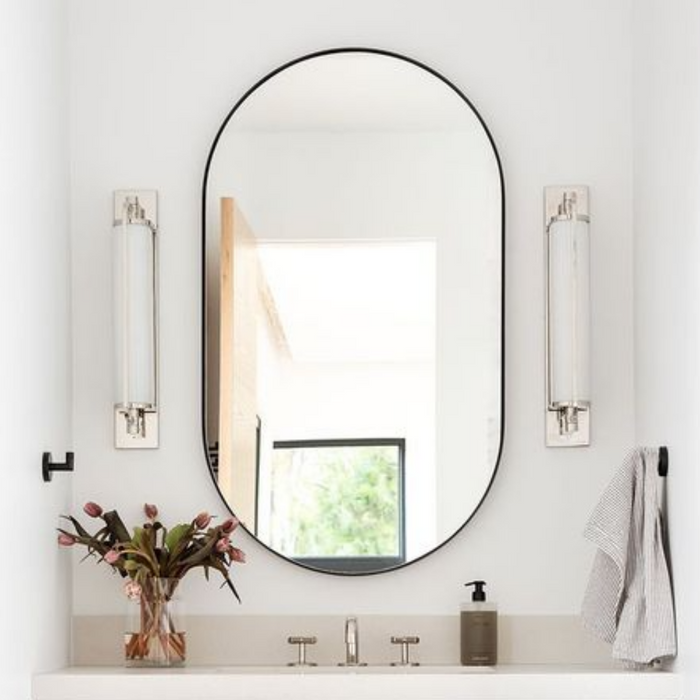
ANDY STAR Matte Black Pill-shaped Bathroom Mirror
Symmetry is huge in any Art Deco design scheme, and while there are plenty of ways to make your space look symmetrical, flanking your mirror with sconces is a particularly eye-catching one. By placing two matching accents so close together, you’ll draw attention to the symmetry you’ve created, making your design choice striking, rather than subtle.
Commit to a Striking Tile Color
:max_bytes(150000):strip_icc():format(webp)/art-deco-bathroom-ideas-3-tyler-karu-hills-beach-924318f941d349c0b6017e14eac47f93.jpeg)
Art Deco is all about crisp shapes and bold colors, so don’t be afraid to go big with your palette. Stock up on tiles in a shade you love looking at and turn your entire shower into a pop of color. And remember, striking doesn’t have to mean bright, though it definitely can if you want it to.
Add Luxury With Drapes
:max_bytes(150000):strip_icc():format(webp)/art-deco-bathroom-ideas-4-reena-sotropa-modern-acreage-1548c93276564bbcbf504be3f8ec840f.jpeg)
Art Deco may be sleek and hard-edged, but it’s also fun and luxurious, so look for opportunities to add glamour to your space. Drapes may not be the first thing you think to hang in your bathroom, but that non-obvious touch of elegance should go a long way.
Set the Scene With Wallpaper

ANDY STAR Brushed Gold Rectangular Pivot Mirror
At its heart, Art Deco is about decoration, and really, what’s more decorative than wallpaper? Snag a bold print in a striking palette to immediately set the tone in your space.
And remember, great peel-and-stick options abound so you can experiment with different statement-making options without getting too committal.
Snag a Showerhead That Looks Like a Chandelier
:max_bytes(150000):strip_icc():format(webp)/art-deco-bathroom-ideas-6-michelle-boudreau-1-191a46290f114969ac66a3f3b38622a1.png)
Many of us have placed showerheads firmly in the utility category and don’t consider them part of our décor scheme, even though they absolutely can be. If you have an eye for detail—and the energy to swap out your showerhead—consider trading your showerhead with an option that suits your Art Deco aesthetic. There are a handful of overhead options that look like sleek chandeliers and deliver cozy showers, to boot.
Go Bold With Your Color Scheme
:max_bytes(150000):strip_icc():format(webp)/art-deco-bathroom-ideas-7-tyler-karu-bath-historic-3-6aa6e01d1a1e4c45bdb7be721d315010.jpeg)
The Art Deco period was a particularly color-filled moment, and pops of color aren’t the only way to pay homage to the era’s palette. If you don’t mind making a statement, consider going all-in on one striking shade. Make your space feel even more Art Deco with a bold light fixture and some eye-catching printed tiles.
Pick a Bas-Relief Cabinet
:max_bytes(150000):strip_icc():format(webp)/art-deco-bathroom-ideas-8-leclair-decor-leclair-2-7e01aac84af749f1a410857a6061eca5.png)
ANDY STAR Matte Black Rectangular Wood Frame Mirror
Bas-relief accents were particularly popular during the Art Deco period. At the time, these accents largely took the form of sculptures. But today, you can still find cabinets and consoles that reference the bas-relief style. Trade your classic vanity for an Art Deco-inspired option—like a wooden cabinet textured with subtly carved lines.
What Is Bas-Relief?
The word relief describes a style of sculpting. Bas-relief (also known as low-relief) sculptures are more subtly carved, and the foreground remains attached to the background. (Consider the surface of a coin, for example.) High-relief sculptures are more obviously carved, with some—or all—foreground elements detached from the background. (Freestanding sculptures are a great example.)
Bring a Print Into Your Shower
:max_bytes(150000):strip_icc():format(webp)/art-deco-bathroom-ideas-9-tyler-karu-bath-historic-2-36b761fbe13a4edda0e199d70e190470.jpeg)
When it comes to outfitting your shower, you don’t have to commit to just one tile style. In fact, if you’re crafting an Art Deco bathroom, you may want to weave in other prints, colors, and textures.
Keep your shower sleek by putting your accent tiles in a few clearly defined areas. The space behind your showerhead is an excellent candidate, and so is the shelf that stores your soap.
Line Your Walls With Shiny Tiles
ANDY STAR Brushed Silver Rectangular Pivot Mirror
Metal accents were popular during the Art Deco period, and while it isn’t necessary to fill your bathroom with metal pieces, you can achieve a similar look by lining your walls with shiny tiles. Stay true to the art deco look by sticking with sleek, geometric tiles. And remember that you can always add texture by snagging shiny tiles in a few different shades.
Invest in Luxe Lighting
:max_bytes(150000):strip_icc():format(webp)/art-deco-bathroom-ideas-11-michelle-boudreau-4-c892cc2c67214abb823b7560ea2d3ead.png)
Lighting is a necessity in any bathroom, and since hanging a few striking light fixtures can be a great way to cement the aesthetic you’re curating, don’t be afraid to go bold. Snag a chandelier that boasts Art Deco’s sleek geometric forms, and bring your space together with a couple of matching sconces.
Pair Stripes With Parallelograms
:max_bytes(150000):strip_icc():format(webp)/art-deco-bathroom-ideas-12-leclair-decor-ld-shoppe-2-4917f1b269ba417fb1d27878e1cff5eb.png)
ANDY STAR Brass Gold 16" Round Mirror
Art Deco is known for its crisp geometry, but don’t limit yourself to classic shapes like circles, squares, and ovals. Remember that less obvious shapes like trapezoids and parallelograms can be just as fun to play with. Keep in mind that striking prints, like stripes and polka dots, can be yet another way to bring shapes into your space.
Put a Marble Inlay in Your Shower
:max_bytes(150000):strip_icc():format(webp)/art-deco-bathroom-ideas-13-reena-sotropa-mardaloop-81f0a9b3e56c4843a016e53a232e9248.jpeg)
Few things scream Art Deco like a marble inlay in a shower. Why? Marble is a luxurious material that pays homage to the glamour of the era. And, depending on the way you structure your inlay, you can also nod to Art Deco’s sleek lines and stepped forms.
You may notice that classic Art Deco buildings, like the Empire State Building and the Chrysler Building, are designed with a Ziggurat-style stepped silhouette. You can achieve a similar look by setting your marble inlay back a bit or designing it to jut out a little.
Play With Shape and Color
:max_bytes(150000):strip_icc():format(webp)/art-deco-bathroom-ideas-14-michelle-boudreau-8-9629f2bb8dfa4d22903e11f6f288c1bc.png)
Shape and color play key roles in any design scheme, but when you’re crafting an Art Deco space, you can pump up the visual volume on both of these elements. To make a serious statement, fill your space with color and render everything in a clearly defined shape. Even smaller details—like drawer pulls and lightbulbs—can make an impact when they’re part of a visual theme.
Take a Risk on Big Triangular Tiles
:max_bytes(150000):strip_icc():format(webp)/art-deco-bathroom-ideas-15-katie-martinez-harbord-2-3dd373552732491fb590afcb6817a220.png)
Triangles don’t make too many appearances in interior design, but in Art Deco spaces, they’re everywhere. If you want to use the motif subtly, you can always trade square backsplash tiles for triangular ones, and if you want to stay true to the Art Deco aesthetic—and go as bold as possible—you can line your floors with big triangular tiles in a few high-contrast colors.
Craft a Sunburst With Your Backsplash
:max_bytes(150000):strip_icc():format(webp)/art-deco-bathroom-ideas-16-reena-sotropa-property-brothers-b9f66dc31c5c4c1fba73ce8b684ebb69.jpeg)
ANDY STAR Brushed Silver 30" Metal Frame Round Mirror
One of the lesser-appreciated motifs from the Art Deco period is the sunburst. Sun-shaped mirrors, headboards, and light fixtures inspired by the period are abundant. And because this is Art Deco we’re talking about, you can rest assured knowing those sunbursts look characteristically geometric and sleek.
Buying a sunburst-shaped mirror is one easy way to incorporate this trend into your bathroom, but another is to use your backsplash tiles to craft a sunburst design that branches out from your mirror as shown above.
Scale Up the Contrast
:max_bytes(150000):strip_icc():format(webp)/art-deco-bathroom-ideas-17-mary-patton-2-97c0ba73469a4755aca5f977a94b8f07.jpeg)
ADNY STAR Brushed Silver Rectangular Mirror
Looking for ways to draw attention to your Art Deco décor scheme? Consider upping the contrast. Instead of pairing your white subway tiles with classic off-white grout, pair them with black grout. And paint your cabinets to match some of the striations in your stunning marble countertops. In both of these cases, the contrast should draw attention to your Art Deco accents, making them even more statement-making than they already are.
Don’t Be Afraid to Get Kitschy
:max_bytes(150000):strip_icc():format(webp)/art-deco-bathroom-ideas-18-studio-peake-chelsea-0d945979b3854706b515df0986a76e81.jpeg)
ANDY STAR Matte Black Metal Frame Round Mirror
Art Deco may be about sleek lines and luxurious details, but it’s also about fun—so don’t be afraid to get a little kitschy. Line your walls with vibrant wallpaper, and pick the shiniest sink you can find. In another décor scheme, these elements might read out-of-place, but surrounded by the sleek-yet-spirited elements that characterize Art Deco, they should fit right in.
Craft a Pattern With Your Tiles
:max_bytes(150000):strip_icc():format(webp)/art-deco-bathroom-ideas-19-jessica-nelson-kirkland-6cd74dfe1956400f954ffbdc6ced082e.png)
Even classic white subway tiles can be transformed into an Art Deco accent if you’re willing to get creative. How? Instead of laying them out traditionally, use them to create a pattern. Flip some of the tiles vertically and some horizontally, and piece them together to create a bold, geometric pattern.
Pick Mirrors That Look Like Prisms
:max_bytes(150000):strip_icc():format(webp)/art-deco-bathroom-ideas-20-reena-sotropa-mardaloop-2-aec677d8f99847ab91a8e1f75ce825b1.jpeg)
It isn’t hard to find an Art Deco mirror. Thanks to the period’s emphasis on geometry, just about any circular, square, or rectangular mirror will do. But if you want something that’s a little less obvious, consider snagging an Art Deco-inspired statement-maker—like a mirror that looks like a prism. The triangles lining the mirror’s edge will nod to the era’s commitment to sleek lines, while adding a little visual interest to your space.
Turn Your Floor Into an Optical Illusion
:max_bytes(150000):strip_icc():format(webp)/art-deco-bathroom-ideas-21-jessica-nelson-cascadia-ave-f7bb0731d66f441bb731d97aae930d1d.jpeg)
Optical illusions aren’t necessarily an Art Deco motif, but the crisp shapes that make up optical illusions—and the way those shapes are often stepped—have a decidedly Art Deco look. If you’re searching for a creative way to lay out your bathroom floors, consider lining them with tiles that look like a striking optical illusion.
Pick Sconces as Tall as Your Mirrors
:max_bytes(150000):strip_icc():format(webp)/art-deco-bathroom-ideas-22-cathie-hong-interiors-belmont-d8b1a02f2a134bf6a31367edcce8205f.jpeg)
ANDY STAR Matte Black Arched Mirror
Your sconces can be any size, but if you want to play up the Art Deco accents in your space, consider snagging sconces that are as tall as your mirrors. This will put your sconces and your mirrors on the same plane, creating an implied pattern out of simple bathroom decor.
Layer in Some Stylized Florals
:max_bytes(150000):strip_icc():format(webp)/art-deco-bathroom-ideas-23-erin-williamson-design-hill-country-3-4812a6e3051f489fa9159ceb1d7876bd.jpeg)
After all this talk of geometry, you may be shocked to hear that floral prints are welcome in an Art Deco space, but that’s the truth. Of course, not all florals fit this bill, but some more stylized options do, and they pair magnificently with crisp lines and shape-filled patterns.
Warm Up Your Space With Gold Accents
:max_bytes(150000):strip_icc():format(webp)/art-deco-bathroom-ideas-24-reena-sotropa-currie-barracks-cb741e23f10342ed8faeab55f673a037.jpeg)
ANDY STAR Brushed Gold Rectangular Bathroom Mirror
Metal accents pervaded the Art Deco period, and they’re still popular in interior design today. If you’re looking for an understated way to make your bathroom feel more Art Deco, consider sprinkling in a few gold accents. By color-coordinating these pieces, you can maintain some of Art Deco’s signature sleekness, while lending your space some welcome warmth.
Create a Wall-to-Wall Pattern
:max_bytes(150000):strip_icc():format(webp)/art-deco-bathroom-ideas-25-mary-patton-3ff716b7b145476c902aac14c5216662.jpeg)
When many of us go to decorate our walls, we stick with classic options like paint or wallpaper. But when you’re dealing with a bathroom, you can just as easily line your walls with tiles, instead. To create more visual impact, consider choosing a set of patterned tiles—or opt for tiles that create a wall-to-wall pattern when combined.
Layer Lines Over Lines
:max_bytes(150000):strip_icc():format(webp)/art-deco-bathroom-ideas-26-house-nine-barnes-mews-073539e950564c6188ac5996047bdea0.jpeg)
Layers are welcome in Art Deco design, so don’t be afraid to pile them on. Use your tiles, your sink, and your vanity to create straight lines running in every direction. Then, bring the motif to the foreground with a statement-making mirror.
Keep Things Symmetrical
:max_bytes(150000):strip_icc():format(webp)/art-deco-bathroom-ideas-27-leclair-decor-gatineau-1-98477bb1e9bc476397376e21ca9d6316.png)
ANDY STAR Matte Black Pill-shaped Mirror
When in doubt, look for ways to add symmetry, as it’s easy to attain. And if you do it obviously enough, it’ll nod to Art Deco—even if you’ve mixed other aesthetics into your space.
But how do you do it obviously? Work in twos. Split one sprawling wall mirror into two smaller matching mirrors, then pair those mirrors with matching sinks and vanity cabinets. If you really want to hammer your point home, add even more symmetrical pairs. Hang matching pendant lights on either side of each mirror, or flank each mirror with a pair of matching sconces.
Go All in on Marble
:max_bytes(150000):strip_icc():format(webp)/art-deco-bathroom-ideas-28-brophy-interiors-the-k-house-400507dfca044852ad118b60268be07d.jpeg)
Marble makes a luxurious addition to any bathroom, and since Art Deco is inherently glamorous, it suits the aesthetic perfectly. Invest in marble countertops or splurge on marble floors, and if you really want to kick things up a notch, you can line your walls with marble, too.
Give Chevron a Chance
:max_bytes(150000):strip_icc():format(webp)/art-deco-bathroom-ideas-29-pure-salt-seacliff-22d629776673424ab75c3d2f324e61a3.jpeg)
Chevron—a zigzag-like pattern formed by inverted Vs—had a serious moment in the mid-2010s. And fun fact: it also had a moment in the Art Deco period. So, let go of any preconceived notions you have about the pattern, and consider welcoming it into your space.
To use chevron more subtly, skip the printed pieces and let the pattern inform your tile layout, instead.
Sprinkle in Decadent Details
ANDY STAR Brushed Gold Pill-shaped Mirror
Pops of color are popular in just about any décor scheme, but when designing an Art Deco interior, you may want to sprinkle in some pops of luxury, as well. Decadent details—like marble-lined pendant lights—can add touches of glamour to your space, making it feel more elegant and of course, more Art Deco too.
Have Fun With It
:max_bytes(150000):strip_icc():format(webp)/art-deco-bathroom-ideas-31-katie-hodges-westgate-1c8818aca94b455794e8e8abb3daf3de.png)
When mimicking a well-known aesthetic, it can be tempting to do everything by the book. But try to have some fun along the way, and focus on crafting a space you’ll love spending time in. (Yes, even bathrooms deserve a little love.)
For one thing, you’re not putting forth all this effort to end up with a space you’re not obsessed with. And for another, Art Deco is chiefly about fun. Stay true to the heart of the aesthetic, and get a little weird.
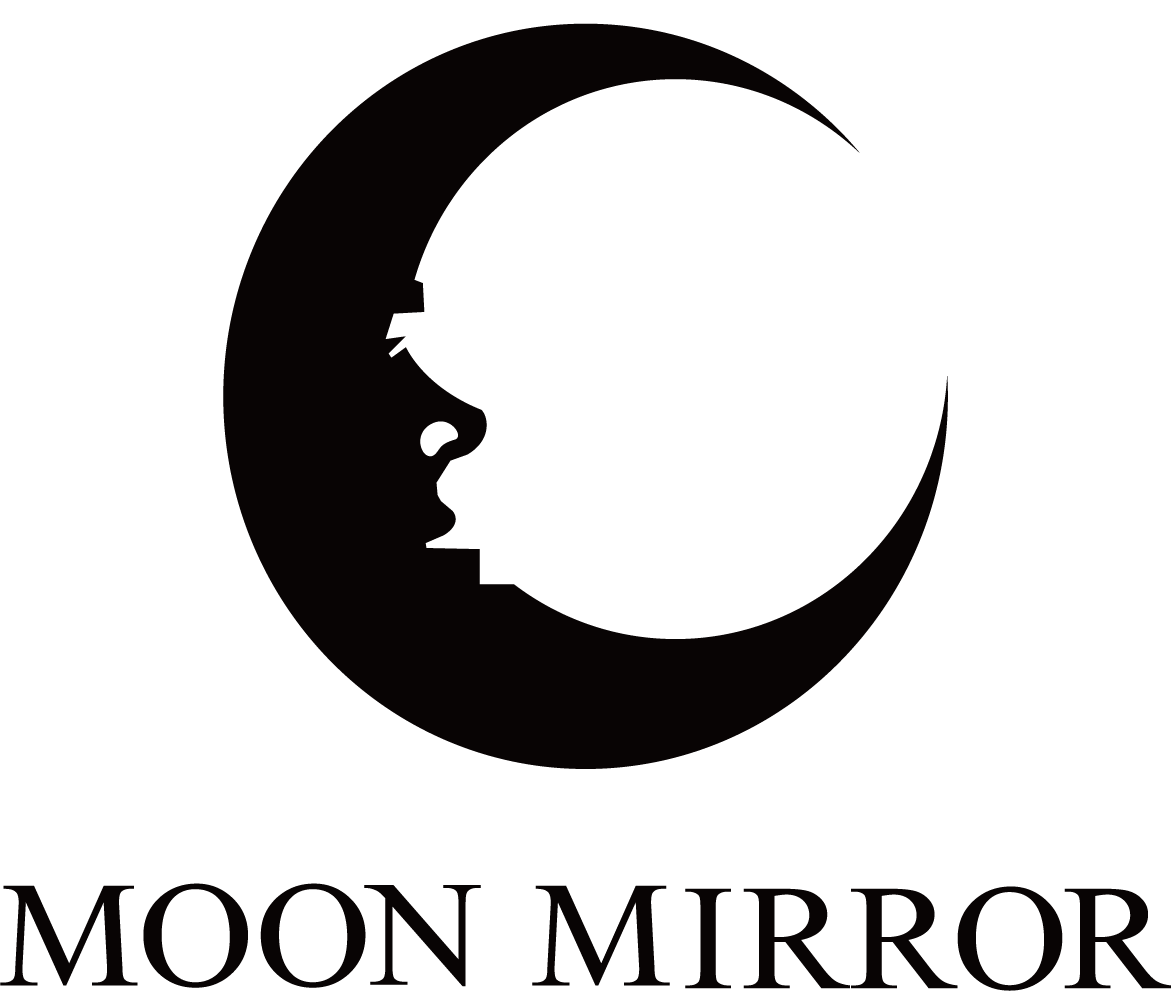
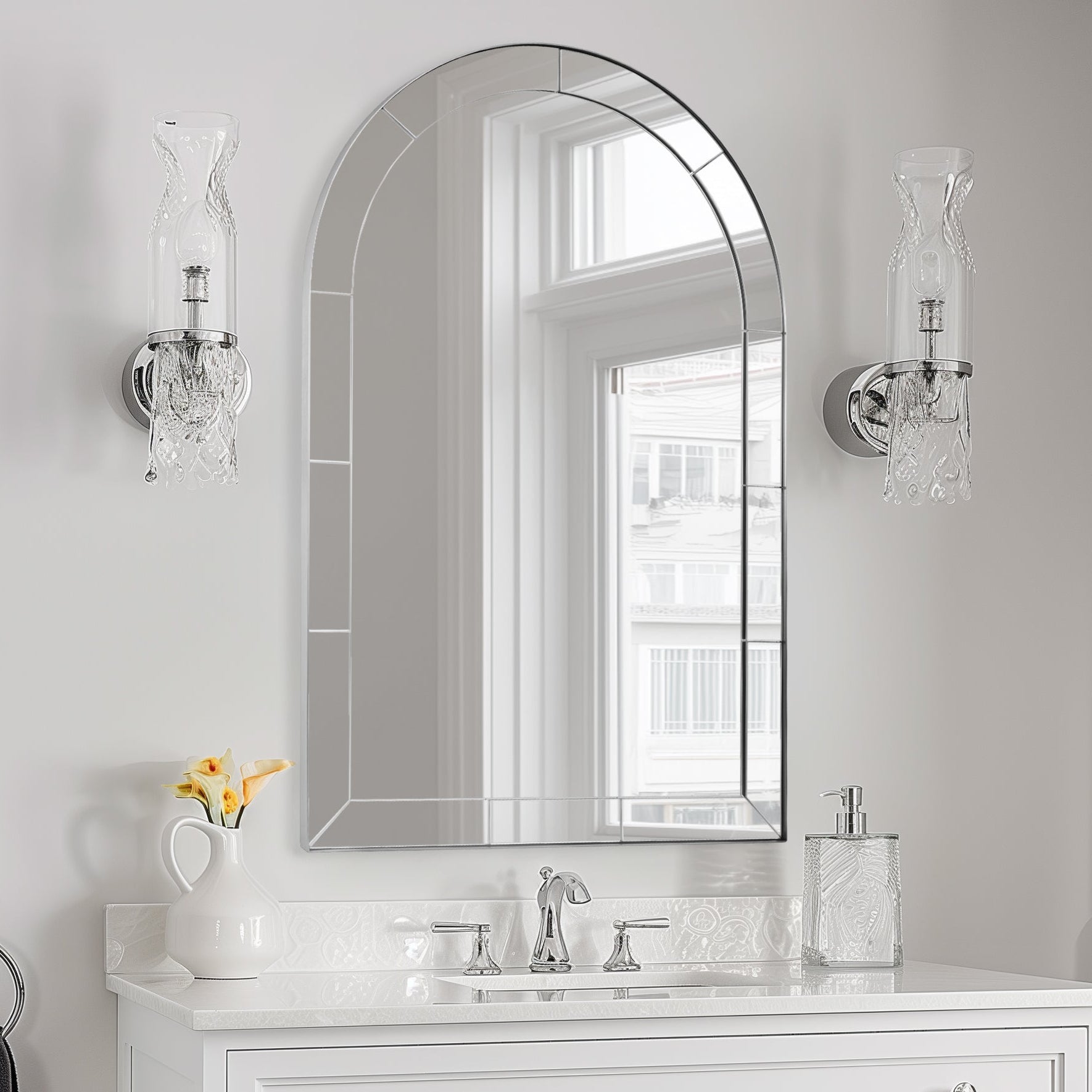






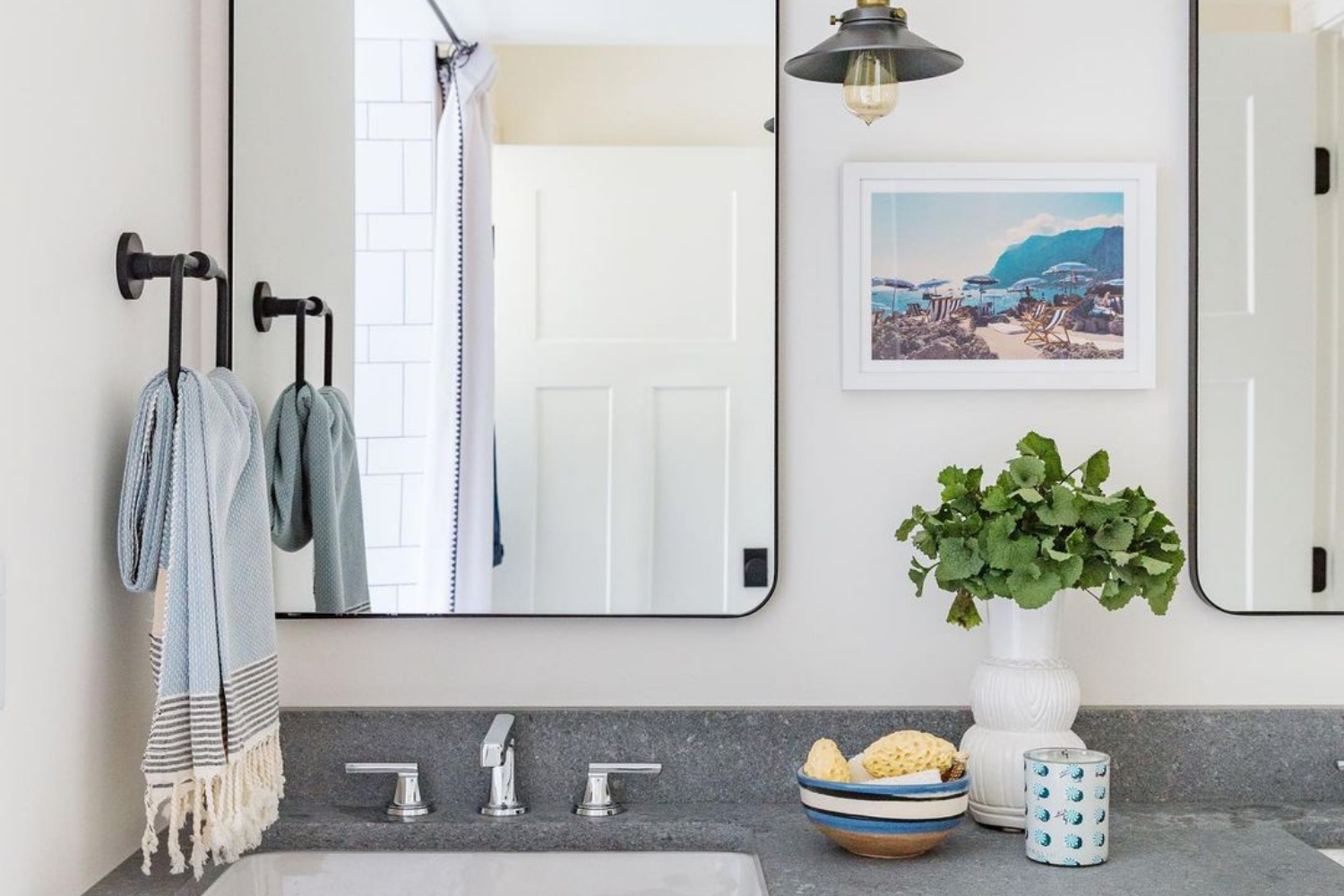


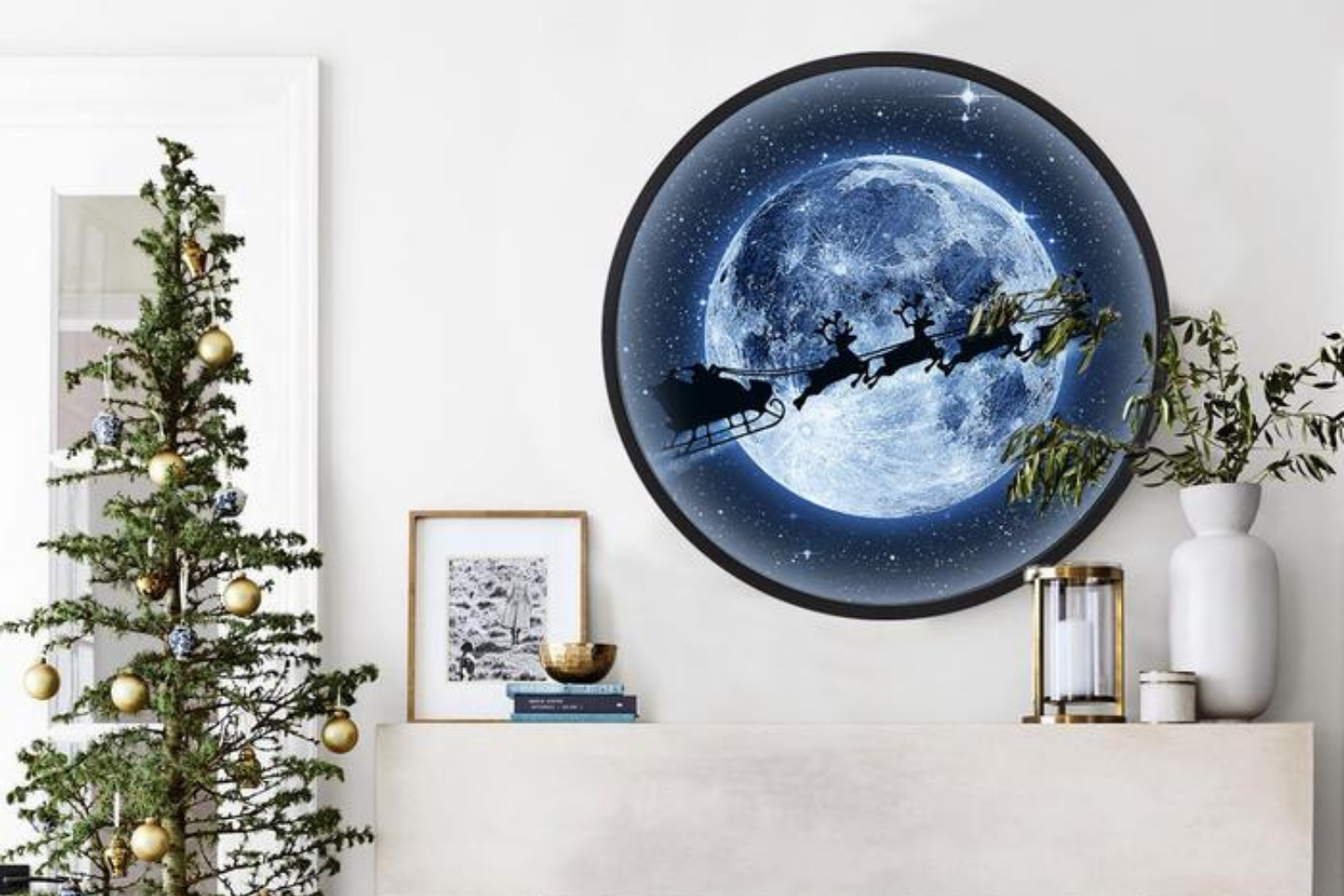
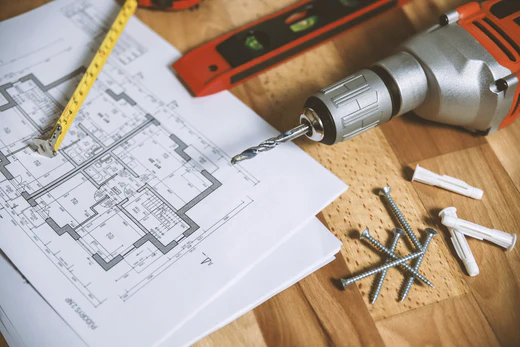











Laisser un commentaire
Ce site est protégé par hCaptcha, et la Politique de confidentialité et les Conditions de service de hCaptcha s’appliquent.